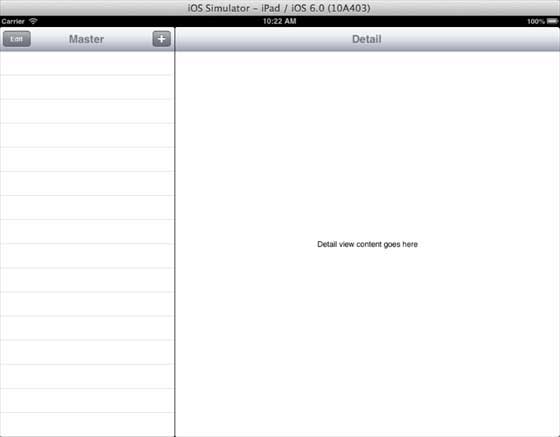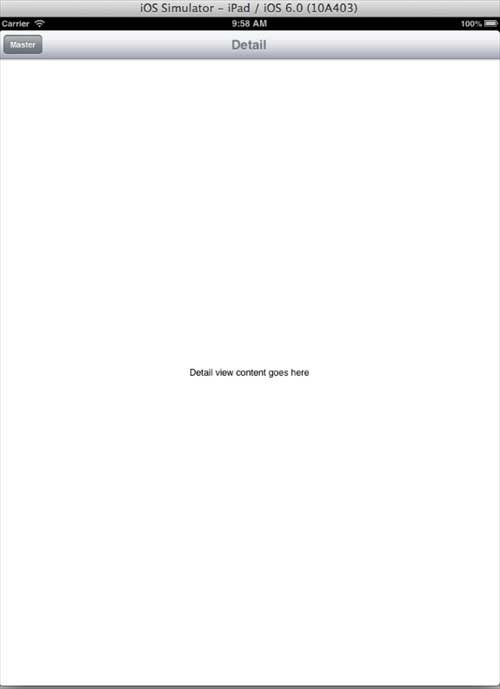iOS - 拆分视图
使用 Split 拆分视图
Split 拆分视图是 iPad 特定的容器,用于并排管理两个视图控制器的视图控制器,左侧是主视图控制器,右侧是详细视图控制器。
重要属性
- delegate
- viewControllers
示例代码和步骤
步骤 1 − 创建一个新项目并选择 Master Detail Application 而不是基于视图的应用程序,然后单击下一步,提供项目名称并选择创建。
步骤 2 − 默认情况下,会在 master 中创建一个简单的拆分视图控制器,其中包含一个表视图。
步骤 3 − 创建的文件与我们基于视图的应用程序略有不同。 在这里,我们为我们创建了以下文件。
- AppDelegate.h
- AppDelegate.m
- DetailViewController.h
- DetailViewController.m
- DetailViewController.xib
- MasterViewController.h
- MasterViewController.m
- MasterViewController.xib
步骤 4 − AppDelegate.h 文件如下 −
实例
#import <UIKit/UIKit.h>
@interface AppDelegate : UIResponder <UIApplicationDelegate>
@property (strong, nonatomic) UIWindow *window;
@property (strong, nonatomic) UISplitViewController *splitViewController;
@end
步骤 5 − AppDelegate.m中的didFinishLaunchingWithOptions方法如下 −
实例
- (BOOL)application:(UIApplication *)application
didFinishLaunchingWithOptions:(NSDictionary *)launchOptions
self.window = [[UIWindow alloc] initWithFrame:[[UIScreen mainScreen]bounds]];
// Override point for customization after application launch.
MasterViewController *masterViewController = [[MasterViewController
alloc] initWithNibName:@"MasterViewController" bundle:nil];
UINavigationController *masterNavigationController =
[[UINavigationController alloc] initWithRootViewController:
masterViewController];
DetailViewController *detailViewController =
[[DetailViewController alloc] initWithNibName:@"DetailViewController"
bundle:nil];
UINavigationController *detailNavigationController =
[[UINavigationController alloc] initWithRootViewController:
detailViewController];
masterViewController.detailViewController = detailViewController;
self.splitViewController = [[UISplitViewController alloc] init];
self.splitViewController.delegate = detailViewController;
self.splitViewController.viewControllers =
@[masterNavigationController, detailNavigationController];
self.window.rootViewController = self.splitViewController;
[self.window makeKeyAndVisible];
return YES;
步骤 6 − MasterViewController.h 如下 −
实例
#import <UIKit/UIKit.h>
@class DetailViewController;
@interface MasterViewController : UITableViewController
@property (strong, nonatomic) DetailViewController *detailViewController;
@end
步骤 7 − MasterViewController.m 如下 −
实例
#import "MasterViewController.h"
#import "DetailViewController.h"
@interface MasterViewController () {
NSMutableArray *_objects;
}
@end
@implementation MasterViewController
- (id)initWithNibName:(NSString *)nibNameOrNil bundle:(NSBundle *)
nibBundleOrNil {
self = [super initWithNibName:nibNameOrNil bundle:nibBundleOrNil];
if (self) {
self.title = NSLocalizedString(@"Master", @"Master");
self.clearsSelectionOnViewWillAppear = NO;
self.contentSizeForViewInPopover = CGSizeMake(320.0, 600.0);
}
return self;
}
- (void)viewDidLoad {
[super viewDidLoad];
self.navigationItem.leftBarButtonItem = self.editButtonItem;
UIBarButtonItem *addButton = [[UIBarButtonItem alloc]
initWithBarButtonSystemItem: UIBarButtonSystemItemAdd
target:self action:@selector(insertNewObject:)];
self.navigationItem.rightBarButtonItem = addButton;
}
- (void)didReceiveMemoryWarning {
[super didReceiveMemoryWarning];
// Dispose of any resources that can be recreated.
}
- (void)insertNewObject:(id)sender {
if (!_objects) {
_objects = [[NSMutableArray alloc] init];
}
[_objects insertObject:[NSDate date] atIndex:0];
NSIndexPath *indexPath = [NSIndexPath indexPathForRow:0 inSection:0];
[self.tableView insertRowsAtIndexPaths:@[indexPath] withRowAnimation:
UITableViewRowAnimationAutomatic];
}
#pragma mark - Table View
- (NSInteger)numberOfSectionsInTableView:(UITableView *)tableView {
return 1;
}
- (NSInteger)tableView:(UITableView *)tableView numberOfRowsInSection:
(NSInteger)section {
return _objects.count;
}
// Customize the appearance of table view cells.
- (UITableViewCell *)tableView:(UITableView *)tableView cellForRowAtIndexPath:
(NSIndexPath *)indexPath {
static NSString *CellIdentifier = @"Cell";
UITableViewCell *cell = [tableView dequeueReusableCellWithIdentifier:
CellIdentifier];
if (cell == nil) {
cell = [[UITableViewCell alloc] initWithStyle:
UITableViewCellStyleDefault reuseIdentifier:CellIdentifier];
}
NSDate *object = _objects[indexPath.row];
cell.textLabel.text = [object description];
return cell;
}
- (BOOL)tableView:(UITableView *)tableView canEditRowAtIndexPath:
(NSIndexPath *)indexPath {
// Return NO if you do not want the specified item to be editable.
return YES;
}
- (void)tableView:(UITableView *)tableView commitEditingStyle:
(UITableViewCellEditingStyle)editingStyle forRowAtIndexPath:
(NSIndexPath *)indexPath {
if (editingStyle == UITableViewCellEditingStyleDelete) {
[_objects removeObjectAtIndex:indexPath.row];
[tableView deleteRowsAtIndexPaths:@[indexPath] withRowAnimation:
UITableViewRowAnimationFade];
} else if (editingStyle == UITableViewCellEditingStyleInsert) {
// Create a new instance of the appropriate class, insert it into
//the array, and add a new row to the table view.
}
}
/*
// Override to support rearranging the table view.
- (void)tableView:(UITableView *)tableView moveRowAtIndexPath:
(NSIndexPath *) fromIndexPath toIndexPath:(NSIndexPath *)toIndexPath {
}
*/
/*
// Override to support conditional rearranging of the table view.
- (BOOL)tableView:(UITableView *)tableView canMoveRowAtIndexPath:
(NSIndexPath *)indexPath {
// Return NO if you do not want the item to be re-orderable.
return YES;
}
*/
- (void)tableView:(UITableView *)tableView didSelectRowAtIndexPath:
(NSIndexPath *)indexPath {
NSDate *object = _objects[indexPath.row];
self.detailViewController.detailItem = object;
NSDateFormatter *formatter = [[NSDateFormatter alloc] init];
[formatter setDateFormat: @"yyyy-MM-dd HH:mm:ss zzz"];
NSString *stringFromDate = [formatter stringFromDate:object];
self.detailViewController.detailDescriptionLabel.text = stringFromDate;
}
@end
步骤 8 − DetailViewController.h 如下 −
实例
#import <UIKit/UIKit.h>
@interface DetailViewController : UIViewController
<UISplitViewControllerDelegate>
@property (strong, nonatomic) id detailItem;
@property (weak, nonatomic) IBOutlet UILabel *detailDescriptionLabel;
@end
步骤 9 − DetailViewController.m 如下 −
实例
#import "DetailViewController.h"
@interface DetailViewController ()
@property (strong, nonatomic) UIPopoverController *masterPopoverController;
- (void)configureView;
@end
@implementation DetailViewController
#pragma mark - Managing the detail item
- (void)setDetailItem:(id)newDetailItem {
if (_detailItem != newDetailItem) {
_detailItem = newDetailItem;
// Update the view.
[self configureView];
}
if (self.masterPopoverController != nil) {
[self.masterPopoverController dismissPopoverAnimated:YES];
}
}
- (void)configureView {
// Update the user interface for the detail item.
if (self.detailItem) {
self.detailDescriptionLabel.text = [self.detailItem description];
}
}
- (void)viewDidLoad {
[super viewDidLoad];
[self configureView];
}
- (void)didReceiveMemoryWarning {
[super didReceiveMemoryWarning];
// Dispose of any resources that can be recreated.
}
- (id)initWithNibName:(NSString *)nibNameOrNil bundle:
(NSBundle *)nibBundleOrNil {
self = [super initWithNibName:nibNameOrNil bundle:nibBundleOrNil];
if (self) {
self.title = NSLocalizedString(@"Detail", @"Detail");
}
return self;
}
#pragma mark - Split view
- (void)splitViewController:(UISplitViewController *)splitController
willHideViewController:(UIViewController *)viewController withBarButtonItem:
(UIBarButtonItem *)barButtonItem forPopoverController:
(UIPopoverController *)popoverController {
barButtonItem.title = NSLocalizedString(@"Master", @"Master");
[self.navigationItem setLeftBarButtonItem:barButtonItem animated:YES];
self.masterPopoverController = popoverController;
}
- (void)splitViewController:(UISplitViewController *)splitController
willShowViewController:(UIViewController *)viewController
invalidatingBarButtonItem:(UIBarButtonItem *)barButtonItem {
// Called when the view is shown again in the split view,
//invalidating the button and popover controller.
[self.navigationItem setLeftBarButtonItem:nil animated:YES];
self.masterPopoverController = nil;
}
@end
步骤 10 − 当我们运行应用程序时,我们将在横向模式下获得以下输出 −

步骤 11 − 当我们切换到纵向模式时,我们将得到以下输出 −


